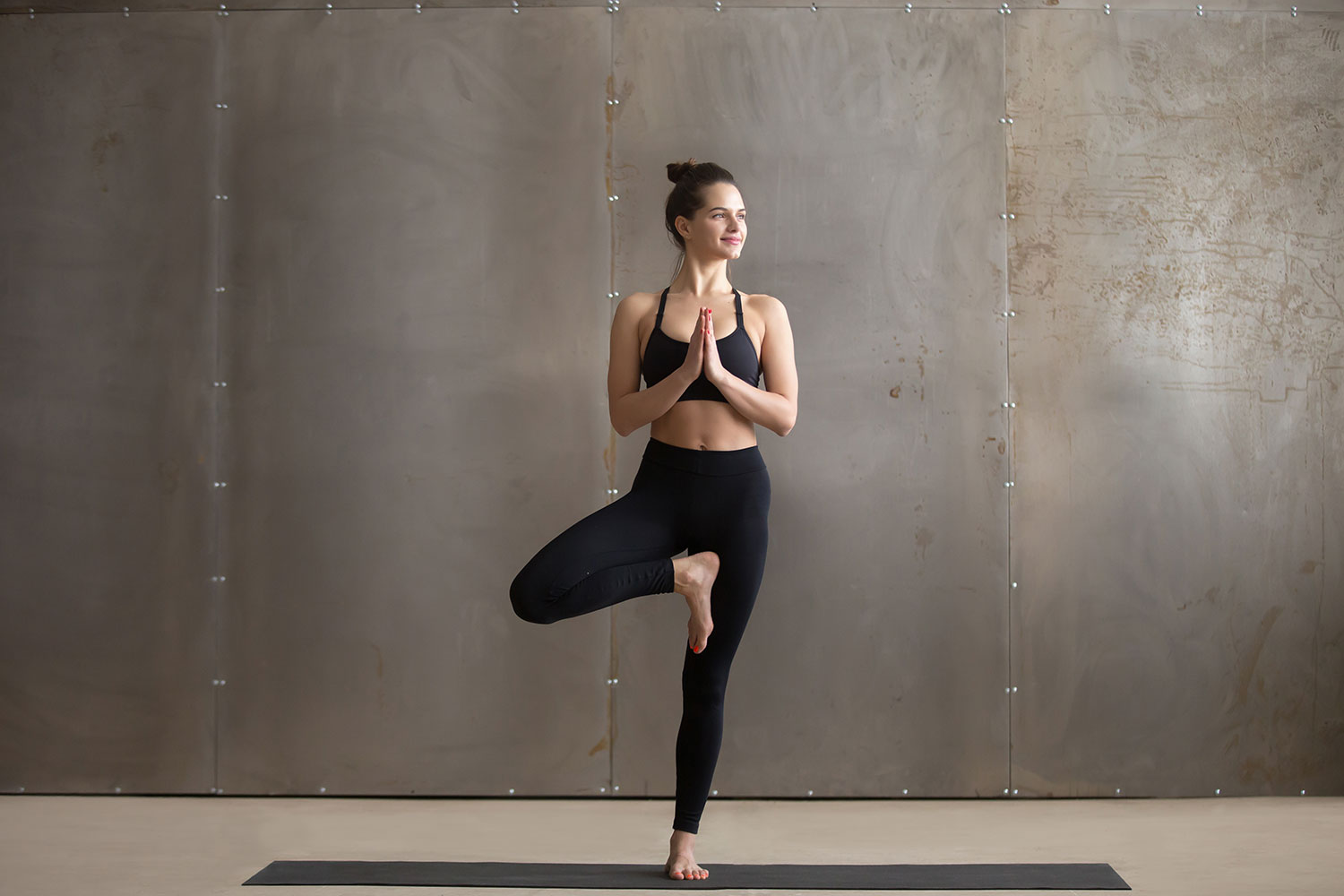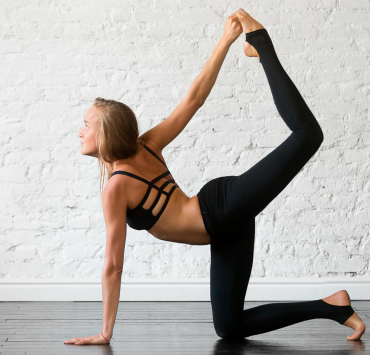
Paving the way for yogic living in Nebraska, Jacqueline Roberts…
Stand tall, sturdy, focused. Bend and sway, but maintain your ground. Root in, raise up.
The famous yoga pose, Vrksasana or tree pose, is a favorite among teachers and students alike. This asana invokes a determined, yet graceful image and can be used to foster a deep connection between the yogi and the Earth itself.
Tree pose roots us while teaching us balance. It challenges us to find a new center, to return to our hearts or to reach ahead. It is a grand pose with many physical and mental benefits. As such, it can often be a challenge for students to master and feel comfortable with. The benefits of mastering this pose are endless, so if you are one who finds tree pose difficult, it’s time to really dig it. Here we will go over not only how to achieve tree pose, but the history of tree pose, the deeper meaning of tree pose, and how to use tree pose in practice and your daily life to fully embrace its power.
The History of Tree Pose

Tree pose and its variations have been used in yoga styles from as early as the 2nd century, where it was mentioned in the Maitri Upanishad.
One Sanskrit story beautifully illustrates the embodiment of tree pose; it is the story of Queen Sita and her unwavering determination.
A demon king, Ravana, captured Queen Sita and brought her to his kingdom in Lanka. He expected her to join him and become his queen, but Sita refused. She was the wife of Rama and knew that he would find her and return her to her rightful home. Ravana was not pleased that Sita had not given into his charms and gifts. If she still refused after 100 days, he would eat her.
Sita was steadfast in her decision to never submit to the demon king. She lived outside the palace in a grove of Ashoka trees. These trees are sacred for their healing and spiritual powers. As Sita sat in her grove, the trees spoke to her, encouraging her to hold her ground and wait for Rama. Her captivity would not last forever, she just needed to be strong and steady.
Later on, Rama and his monkey friend Hanuman were able to find and save Sita. Her faith and determination were rewarded. She stood firm and did not give into the negotiations of Ravana. She took on the power of the steady trees and she was saved.
Trees have long been considered symbols of longevity, strength, courage, and determination. They show us how grand we can be if we stick to our goals. One little seedling can become a mighty oak tree with enough determination and focus. Trees are also a sign of peace, growth, and reliability. They provide a link between God or spirituality and the Earth.
Embodying the tree in a pose like Vrksasana can help us to find our own power and connection to God, the higher self, or the universe. Tree pose is our connection to the Earth and our physical reminder to stay true and strong.
The Health Benefits of Tree Pose

Tree pose stimulates both body and brain, and practicing this pose regularly can bring about fabulous changes in your physical and emotional health.
Improves balance and stability
It’s no surprise that Tree Pose has the unique ability to massively improve balance. As we focus our attention and weight onto one leg, we are allowing all those muscles of the leg to adjust to a new stance. This teaches our muscles to hold us in new and challenging ways, while we focus our inner attention on what lies ahead.
Strengthens ligaments and tendons of the feet
Tree pose is a fantastic pose for strengthening the entire lower limb, but has an especially strong impact on the feet. Our feet house 26 bones, 33 joints, and over 100 muscles. They are our root to the earth below. These complex aspects of our anatomy deserve the care and attention to function at their best!
Strengthens the muscles of the legs and buttocks
In our modern lives, we often spend too much time sitting down at a desk or in our cars. Over time, this loosens and weakens the muscles of the leg, including the ever-important gluteal muscles. Our glutes are crucial elements for our ability to move, but also support our entire backs. With stronger glute muscles, you can ward off back pain and injury and stay active long into old age.
Enhances emotional balance and confidence
Standing in postures that mimic victory, strength, endurance, and stability will make your brain actually feel that you are these things. Tree pose is a determined and confident pose to take on whenever you are feeling like you need that extra boost of self-esteem or power. In addition, the balancing nature of this pose helps the brain to rebalance and can help you find “new footing” in your mental and emotional life.
How to do Tree Pose

Now that we have explored the history, symbolism, and benefits of Tree Pose, let’s get down to it!
- Stand firmly in Mountain pose, with your feet planted on the ground, back straight, and gaze forward. Put your arms by your side. Make sure to distribute your weight evenly across the soles of both feet.
- Slowly shift your weight on to the left foot, then bend your right knee up. Reach to grasp your right ankle and guide your right foot along your inner left thigh.
- Find a comfortable place to rest your foot. Choose either above or below the knee, not directly over it. You may choose to rest your foot in your groin, or gently at the lower leg.
- Make sure the center of your pelvis is over your left foot to maintain alignment and balance. Place your hands on your hips for balance, and focus on lengthening your tailbone to the floor.
- Raise your hands, bringing them together in prayer position at the level of the chest. Choose a point directly in front of you in the distance to focus your attention and gaze.
- As you settle into Tree pose, press the right foot into the left leg. Press down into the ground with the left foot, steadying yourself and drawing in strength.
- When you are stable and steady, breathe in and raise your arms overhead with your fingertips pointing to the sky. You can stay here with palms facing each other, fingertips splayed, or choose to bring the palms together in an overhead prayer position.
- Rest here in the final moments of Tree pose for one minute, or longer if you can. Focus your gaze ahead and maintain your stable stance.
- Gently return to mountain position by drawing the arms back down, grasping the right foot and releasing it from its hold on the leg. Bring the right foot back down to the ground and find your stance in mountain pose.
- Repeat on the opposite side.
Modifications, Variations, and Tips for Mastering Tree Pose

Tree Pose is an adaptable pose for many different body shapes, levels, and goals. Here are a few different modifications for different types of students.
- Practice Tree Pose with different heights of the raised foot. Try the foot resting just at the shin, below the knee, the mid-thigh, or resting in the groin.
- If you are having trouble balancing, rather than raising the foot up to the opposite leg, rest the toes on the ground and point your knee out to the side.
- Practice Tree Pose with your back against a wall for added support or to focus on keeping a straight back.
- For a challenge, with arms raised overhead close your eyes and practice balance with your inner knowing.
- Stay slow. Balancing postures are often best approached with a slow and steady mentality. Don’t rush to rise up to Tree; instead, take each movement with dedicated awareness and focus. You will not only balance more easily, but you will build better control of your muscle groups.
- Get comfortable with Mountain Pose. If you haven’t yet mastered the intricacies of Mountain pose, return to this simple (yet profound) staple and really ground in.
- Imagine a straight line running from the crown of your head, through your spine, into your leg and foot and down into the ground.
- If you are struggling with balance or stability in Tree pose, you may need to boost your abdominal muscles. Strong abdominals will improve your stance in Tree Pose and help you balance better in general. Practice Boat Pose to achieve better results with Tree Pose.
A Note on Practicing Tree Pose Safely

Tree Pose is an excellent pose for just about anyone. However, there are some instances in which practicing Tree Pose may not be ideal. This includes those people who suffer from headaches, low blood pressure, dizziness, fainting, or general light-headedness. If you have high blood pressure, make sure to keep your arms at heart center, rather than raising them overhead. Take caution in pregnancy.
Embody the Mighty Tree with Vrksasana
Tree Pose is an amazing pose to practice your balance, strength, and fortitude. Trees are one of the most prized symbols of strength, vitality, balance, perseverance, and pride in many cultures. Practicing Tree Pose regularly will not only improve your body’s strength and balance but will also help you find strength and balance in your everyday life. You will learn to embody the power of the tree and stand tall with poise, confidence, and fortitude.
What's Your Reaction?
Paving the way for yogic living in Nebraska, Jacqueline Roberts is adored by her students as a constant source of support and inspiration. A knack for writing allows her to share what she has learned with the world.














